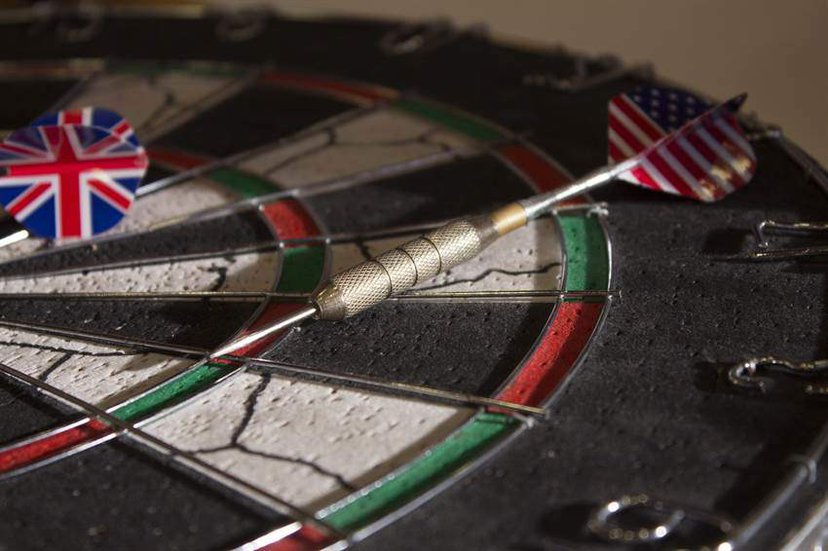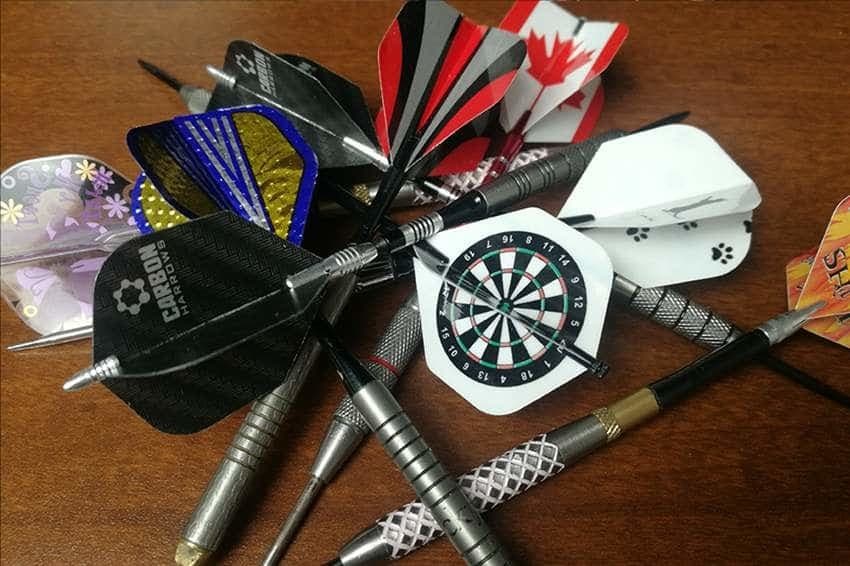There are many things to consider when choosing a dart. Whether you are buying your first set or just looking to upgrade, if you are thinking about purchasing some darts and you are not sure where to start, this list will help you make the best choice possible.
If you are just starting out and looking for a set that won’t break the bank, my recommendation for the best beginner darts are the Fat Cat Bulletz 90% Tungsten Steel Tip Darts.
Steel Tip or Soft Tip
Before you even start looking for your new set of darts, you have to decide on whether you need steel or soft tip darts. For most this decision does not require much thought. It will be based upon where you are playing your darts. Whether at home, in the pub or a league, you should buy the darts type that is right for the board and go with that.
Still unsure you can check out our article on how to decide if you need soft tip or steel tip darts.
Budget

The very first thing you must consider before deciding which set of darts to buy is the price.
This is tricky because the cost will not, by any means, be the most indicative factor of the quality of your experience. In other words, spending more money will not necessarily equate to having a better time when playing or becoming a better player.
Nevertheless, while darts that are more expensive are typically better engineered and constructed out of higher quality materials, the real question becomes, is the hike in price worth it? This is where you must analyze and examine your personal circumstances and decide if you are okay spending 30 dollars or 300.
The more expensive end of the spectrum can offer thinner and more durable darts, which can positively affect your level of play and the longevity of your investment, but here you will also find “flashy” darts that charge a premium based on aesthetics only and these provide no added cost-benefit. On the cheaper side, you will discover darts that are not as uniformly built, which will affect your precision to a certain degree.
Buying cheaper sets will also allow some financial breathing room and permit you to obtain more darts, which is always a good thing. In fact, we recommend having two sets of darts, over time you will find your styles can vary from night to night.
The bottom line is that you will ultimately be judged by your skill as a player and not by how deep your pockets go.
Many professionals prefer cheaper darts, and there is no shame in doing the same. Either way, there are excellent options on both ends of the price spectrum, so take your time to decide.
Material
The material used for the construction of the barrel should also play a role in your decision. The material is significant because the barrel’s composition will define other essential variables such as weight, size, sturdiness, and feel.
The most common materials used in the manufacture of dart barrels are brass, nickel, tungsten, or a combination of various metals.
Brass barrels are typically the cheapest option; however, they are not very durable.
Nickel barrels are generally more durable but cost more.
Tungsten barrels are preferred in professional circles because of the metal´s unique physical characteristics.
Tungsten is a very dense metal, and this allows the industry´s manufacturers to build thinner barrels that enable tighter groupings to be achievable, without sacrificing the weight of the dart itself. Unless you like the feel of a bigger dart, tungsten will be the choice for most.
Weight
Weight is one of the most variable and personal factors to affect your performance. Each player must carefully choose his or her dart´s weight to match their individual dart throwing style.
As a general rule, heavier darts will fly straighter through the air. Experienced or advanced players better use heavier darts because they demand better precision. Inversely, lighter darts fly in a more parabolic trajectory which makes them the prime choice for beginners who rely less on accuracy.
Either way, none of this is set in stone and professionals might prefer lighter darts just as amateurs might have a preference for the heavier kind. The best way to find out which is best for you is to take a few minutes to play some games using various weights until you feel comfortable with your choice.
The most common dart weights are between 16 to 26 grams; however, modern rules allow darts to weigh up to 50 grams.
Ideally, you should begin practicing with darts that weigh around 20 grams. These are the most common and will allow you to move up to higher weights or down to lighter ones. If you habitually throw too high, you should probably use heavier darts and vice versa.
Length and Shape

As with weight, barrel length and shape is another personal choice. Darts come in all shapes and sizes from short torpedo style to long slim cylinders.
How big your hands are and how you hold a darts will affect the size of the barrel you choose. Generally the more fingers you use with your dart grip, the longer a barrel you will want. Unless you like to grip with your fingers resting on the tip.
Choosing a longer barrel will give you more space to grip the dart, while shorter barreled darts will limit your grip options.
The shape of your dart plays a significant role in weight distribution, which is a factor in how your darts fly. The shape of your dart will affect whether the dart is balanced or more front heavy.
Pro players generally use a slimmer barrel as it is easier to squeeze more of them in a tight space. As your grouping becomes tighter over time, this is something you will need to consider. For now, I would say go with what feels right.
Grip
The barrel functions as the point of contact between your fingers and the dart itself; therefore, great thought should be given to the grip.
As you learn more about darts and the many intricacies of the sport you will undoubtedly notice that some dart barrels are smooth while others are heavily knurled. This is because the texture of the dart barrel provides the friction necessary for a proper grip.
Dart manufacturers will add grooves, cuts, ridges, and bumps in an effort to make a dart more easy to hold and reduce slippage.
Typically, the heavier the knurling, the more secure the grip you will be able to achieve. Knurled rings offer the best grip by providing a very rough surface, but the flip side is that heavy knurling can sometimes cause the dart to stick to your fingers at the moment of release and this can throw your game off considerably.
Shaft
Shafts (also known as stems) connect the barrel to the flight. The length of the shaft is particularly crucial because the shaft will provide stability to the dart as it flies through the air.
As a general rule, the longer the shaft is, the more unstable the dart´s flight path will be. However, long shafts drastically reduce the risk of crowding the dartboard as well as reduce the chance of bounce-outs. Inversely, shorter shafts enable more stable throws but increase the risk of bounces.
Dart manufacturers offer shafts models with variable lengths and even spinning ends. Shafts are easy to change, so they allow more proficient players to tailor their experience better and adapt their strategy on the fly.
The spinning bodies are a neat little feat of engineering that helps players achieve tighter group clusters by decreasing friction at the point of impact. The spinning shafts can glide past each other effortlessly and are thus more likely to ensure your dart makes it into the board.
Shafts can be made out of plastic, aluminum, and various other metals alloys such as tungsten. The material of your dart shaft has less to do with the flight and more to do with the way the dart behaves after impact.
The overall longevity of your dart will depend to a high degree on the material chosen here. Plastic or nylon options are widely available but are generally more fragile and prone to break. Metal shafts, on the other hand, provide a lot more resistance and durability.
Flight
Another critical factor to consider when choosing the right dart set for you is the type of flight your darts will have. Dart flights are not unlike the fletching at the end of traditional arrows; these are fins, or vanes, made out of various materials, which provide aerodynamic stabilization to the dart during flight.
Having a type of flight that compliments your dart throwing style is important because the kind of flight used will have a significant influence on your dart´s path through the air after it has been thrown.
By and large, we can divide flights into two distinct subtypes: Fast Flights and Slow Flights.
Fast flights will be smaller and longer than the slow counterparts, which means that they have a lower total surface area and this provides more aerodynamic force to cut through the air more efficiently. Fast flights will be more beneficial for players that prefer speedier pitching by providing more precision and stability at high velocities.
Slow flights, on the other hand, typically have a larger surface area ratio and they are usually on the shorter side. By having a marginally larger surface area, the flight can induce significantly more air resistance across the surface of the dart, which has the effect of causing the flight to take a longer path through the air. Players with a more controlled pitch typically prefer slower flights.
On the market, you will find a high degree of variability in flight lengths and sizes. If you take your time to do a little research, finding an option that is well suited to your particular throwing style should not be too complicated. Again, the best way to do this is to practice; play a few games of darts with flights of different sizes and lengths to determine which subtype works best with your style.
Accessories
Last on this list is often overlooked, but if you buy some accessories along with your darts, you will be saving money in the long run. There is a wide variety of accessories for you to pick and choose from and what you need will depend on what type of dart you end up settling for.
For example, if you decide to purchase some steel tip darts with screw-on shafts, you will need a sharpener and tightening tool. Similarly, if you go for nylon shafts, you will need to purchase metal dart ring grips to keep the flights from shifting during the game.
Your darts will also need to be held in a safe place to protect them from warping or cracking unnecessarily. Seriously consider purchasing a quality protective case (we like the Harrows Ace Case).
Choosing a set of darts is a very personal choice and there are so many options it can be overwhelming. Of course, some of the things on this list like flights and shafts are easily changeable if you made the wrong decision or your style changes. If you are looking for a new set of darts, or maybe even your first set of darts, I recommend these Fat Cat Steel Tips as the best all-around starter set.
Check out our full beginner’s guide to steel tip darts for information on everything you need to get started at home (dartboards, cabinets, and more).




